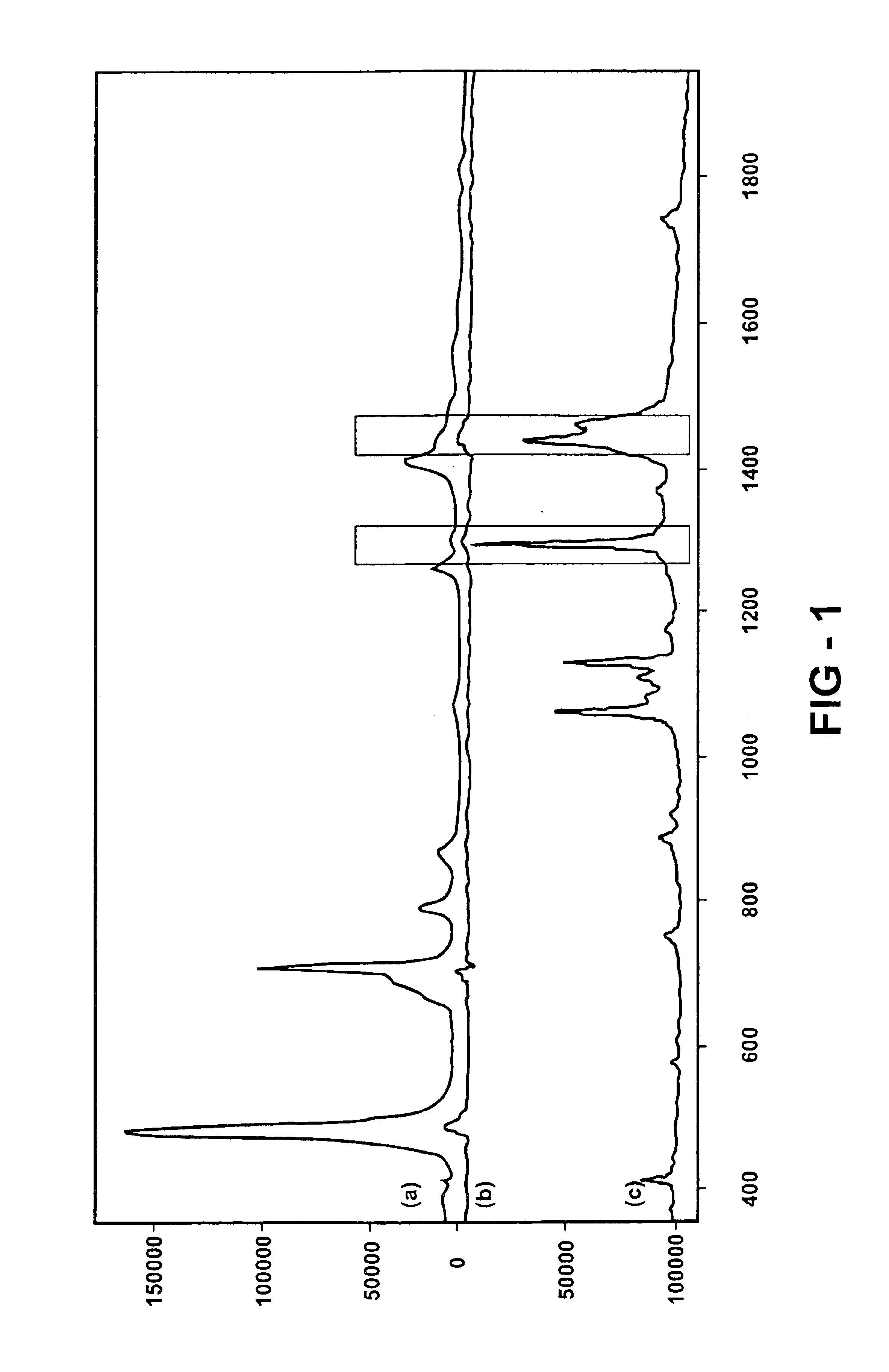Raman spectroscopy crystallization analysis method
a raman spectroscopy and crystallization analysis technology, applied in the direction of spectrometry/spectrophotometry/monochromators, instruments, optical radiation measurement, etc., can solve the problems of limited applicability, many crystallization reactions lacking adequate in situ monitoring, offline sampling cannot provide information in a timely manner
- Summary
- Abstract
- Description
- Claims
- Application Information
AI Technical Summary
Problems solved by technology
Method used
Image
Examples
example 1
A RamanRxn1 analyzer (Kaiser Optical Systems, Ann Arbor, Mich.) was interfaced to a two liter reaction vessel through the use of an 18 inch long fiber optic immersion probe sealed with a sapphire window (Kaiser Optical Systems). The Raman spectra were collected using approximately 100 milliwatts of 785 nanometer laser excitation. This setup yielded a spectral resolution of approximately four wave numbers. The reaction vessel was a two liter temperature controlled reaction vessel. The reaction vessel was charged with a saturated solution of tribehenin (1,2,3-propspanetriyl ester of docosanoic acid) dissolved in an equimolar solvent mixture of cyclomethicone and dimethicone. Reaction temperature and monitoring is performed with a reaction calorimeter.
Before recording any crystallization data, Raman spectra in a low wave number spectral region are collected from the reactor contents of the saturated tribehenin solution, as shown in FIG. 1(a). The spectrum is also plotted in FIG. 1 afte...
example 2
Raman spectra are collected at one minute intervals, with each recorded spectrum being a sum of five spectra each integrated for 10 seconds. The temperature profile is sampled in conjunction with the Raman spectrum collection rate using the reaction calorimeter and thermal controller, as shown in FIG. 4. The Raman spectra of the tribehenin product isolated from the reaction are shown in FIG. 2(a) while that of the solvent is depicted in FIG. 2(b). Those spectral bands of the tribehenin product delineated with an asterisk are associated with the sapphire window of the immersion optic. Integrating baseline subtracted peak area in the C—H stretch region of the tribehenin Raman spectrum from 2730 to 3055 wave numbers following baseline correction as shown in FIG. 3(a) is plotted as a relative intensity as a function of scan number in FIG. 3(b). An increase in integrated peak area is noted most dramatically in spectrum numbers 48-70 and corresponds to pre-nucleation tribehenin-tribehenin...
example 3
The experiment of Example 2 is repeated substituting brassidic anhydride (trans-13-docosanoic anhydride) for tribehenin. Brassidic anhydride is known to form needles upon crystallizing from ethanol and plates upon crystallizing from diethyl ether. The experiment of Example 2 is repeated with brassidic anhydride dissolved in anhydrous ethanol and repeated in anhydrous diethyl ether. Brassidic anhydride has a melting temperature of about 64° Celsius and as such the thermal profiles of Example 2 were reproduced. A comparison of Raman spectra data sets for brassidic anhydride crystallized from ethanol and diethyl ether spectral differences are noted that correlate to the differential cross section of the respective crystalline forms. Where the differential cross section is given by ∂σ∂Ω(Q)=NpVp2(Δ δ)2P(Q)S(Q)+Binc
where Np is the number concentration of scattering bodies (given the subscript “p” for “particles”), Vp is the volume of one scattering body, (Δδ)2 is the square of th...
PUM
| Property | Measurement | Unit |
|---|---|---|
| wavelength | aaaaa | aaaaa |
| wavelength | aaaaa | aaaaa |
| wavelength | aaaaa | aaaaa |
Abstract
Description
Claims
Application Information
 Login to View More
Login to View More - R&D
- Intellectual Property
- Life Sciences
- Materials
- Tech Scout
- Unparalleled Data Quality
- Higher Quality Content
- 60% Fewer Hallucinations
Browse by: Latest US Patents, China's latest patents, Technical Efficacy Thesaurus, Application Domain, Technology Topic, Popular Technical Reports.
© 2025 PatSnap. All rights reserved.Legal|Privacy policy|Modern Slavery Act Transparency Statement|Sitemap|About US| Contact US: help@patsnap.com



